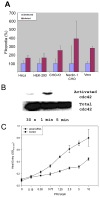A role for heparan sulfate in viral surfing
- PMID: 19909728
- PMCID: PMC2812628
- DOI: 10.1016/j.bbrc.2009.11.027
A role for heparan sulfate in viral surfing
Abstract
Heparan sulfate (HS) moieties on cell surfaces are known to provide attachment sites for many viruses including herpes simplex virus type-1 (HSV-1). Here, we demonstrate that cells respond to HSV-1 infection by enhancing filopodia formation. Filopodia express HS and are subsequently utilized for the transport of HSV-1 virions to cell bodies in a surfing-like phenomenon, which is facilitated by the underlying actin cytoskeleton and is regulated by transient activation of a small Rho GTPase, Cdc42. We also demonstrate that interaction between a highly conserved herpesvirus envelope glycoprotein B (gB) and HS is required for surfing. A HSV-1 mutant that lacks gB fails to surf and quantum dots conjugated with gB demonstrate surfing-like movements. Our data demonstrates a novel use of a common receptor, HS, which could also be exploited by multiple viruses and quite possibly, many additional ligands for transport along the plasma membrane.
Copyright 2009 Elsevier Inc. All rights reserved.
Figures



Similar articles
-
Herpes simplex virus glycoprotein B binds to cell surfaces independently of heparan sulfate and blocks virus entry.J Virol. 2005 Sep;79(18):11588-97. doi: 10.1128/JVI.79.18.11588-11597.2005. J Virol. 2005. PMID: 16140736 Free PMC article.
-
Mutations in the N termini of herpes simplex virus type 1 and 2 gDs alter functional interactions with the entry/fusion receptors HVEM, nectin-2, and 3-O-sulfated heparan sulfate but not with nectin-1.J Virol. 2003 Sep;77(17):9221-31. doi: 10.1128/jvi.77.17.9221-9231.2003. J Virol. 2003. PMID: 12915538 Free PMC article.
-
Expanding the role of 3-O sulfated heparan sulfate in herpes simplex virus type-1 entry.Virology. 2010 Feb 20;397(2):389-98. doi: 10.1016/j.virol.2009.11.011. Epub 2009 Dec 11. Virology. 2010. PMID: 20004926 Free PMC article.
-
Viral entry mechanisms: cellular and viral mediators of herpes simplex virus entry.FEBS J. 2009 Dec;276(24):7228-36. doi: 10.1111/j.1742-4658.2009.07402.x. FEBS J. 2009. PMID: 19878306 Free PMC article. Review.
-
Receptors and ligands for herpes simplex viruses: Novel insights for drug targeting.Drug Discov Today. 2022 Jan;27(1):185-195. doi: 10.1016/j.drudis.2021.10.004. Epub 2021 Oct 19. Drug Discov Today. 2022. PMID: 34678489 Review.
Cited by
-
Real Time Analysis of Bovine Viral Diarrhea Virus (BVDV) Infection and Its Dependence on Bovine CD46.Viruses. 2020 Jan 17;12(1):116. doi: 10.3390/v12010116. Viruses. 2020. PMID: 31963539 Free PMC article.
-
An important role for syndecan-1 in herpes simplex virus type-1 induced cell-to-cell fusion and virus spread.PLoS One. 2011;6(9):e25252. doi: 10.1371/journal.pone.0025252. Epub 2011 Sep 21. PLoS One. 2011. PMID: 21957484 Free PMC article.
-
Extended Release of an Anti-Heparan Sulfate Peptide From a Contact Lens Suppresses Corneal Herpes Simplex Virus-1 Infection.Invest Ophthalmol Vis Sci. 2016 Jan 1;57(1):169-80. doi: 10.1167/iovs.15-18365. Invest Ophthalmol Vis Sci. 2016. PMID: 26780322 Free PMC article.
-
Breaching the Barrier: Investigating Initial Herpes Simplex Viral Infection and Spread in Human Skin and Mucosa.Viruses. 2024 Nov 18;16(11):1790. doi: 10.3390/v16111790. Viruses. 2024. PMID: 39599904 Free PMC article. Review.
-
Liposome-Mediated Herpes Simplex Virus Uptake Is Glycoprotein-D Receptor-Independent but Requires Heparan Sulfate.Front Microbiol. 2016 Jun 22;7:973. doi: 10.3389/fmicb.2016.00973. eCollection 2016. Front Microbiol. 2016. PMID: 27446014 Free PMC article.
References
-
- Gorsi B, Stringer SE. Tinkering with heparan sulfate sulfation to steer development. Trends Cell Biol. 2007;17:173–177. - PubMed
-
- Liu J, Thorp SC. Cell surface heparan sulfate and its roles in assisting viral infections. Med Res Rev. 2002;1:1–25. - PubMed
-
- O’Donnell CD, Tiwari V, Oh MJ, Shukla D. A role for heparan sulfate 3-O-sulfotranferase isoform 2 in herpes simplex virus type 1 entry and spread. Virology. 2006;346:452–459. - PubMed
Publication types
MeSH terms
Substances
Grants and funding
LinkOut - more resources
Full Text Sources
Other Literature Sources
Miscellaneous

